| SILKYPIX® Developer Studio 4.0 | SOFTWARE MANUAL |
| 6. Useful Functions for Adjustment | ||||||||
6.1. Highlight/Shadow/Outside of Color Gamut Warnings
This software has warning functions to support parameter adjustment.
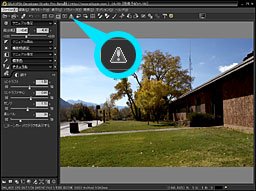 When you click the
When you click the  button on the toolbar, you can enable each warning.
button on the toolbar, you can enable each warning.
A warning will be displayed through blinking on the preview image.
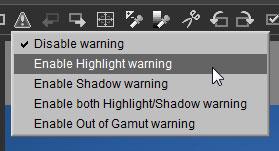 The portion where highlight or color is saturated blinks.
The portion where highlight or color is saturated blinks.
The portion where highlight is saturated blinks in black, and the portion where color is saturated blinks in negative color.
This function is convenient for adjusting "exposure bias" and for adjusting "saturation" of color.
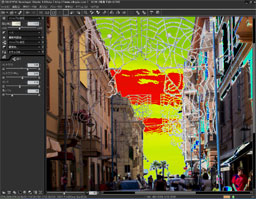
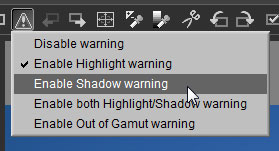 The portion where the shadows are underexposed blinks in white.
The portion where the shadows are underexposed blinks in white.
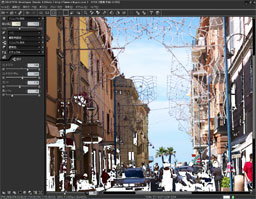
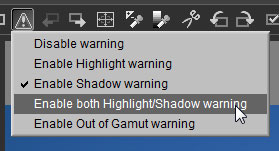 This feature gives both the highlight warning and shadow warning simultaneously.
This feature gives both the highlight warning and shadow warning simultaneously.
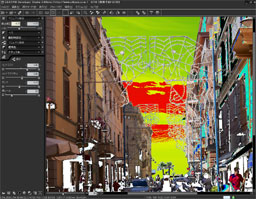
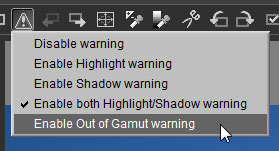 This feature gives a warning for the portion where the color is outside of the color gamut. It means that the saturation in this portion is to high.
This feature gives a warning for the portion where the color is outside of the color gamut. It means that the saturation in this portion is to high.
Please refer to '10.1.6 Color Gamut and Adjustment Outside of Gamut'.
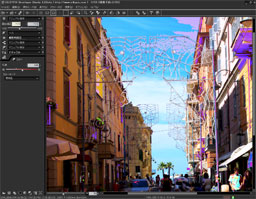
You can customize these warning levels. Please refer to '9.3 Function Setting'.
 When you click the
When you click the  button on the toolbar, you can enable each warning.
button on the toolbar, you can enable each warning.A warning will be displayed through blinking on the preview image.
| (1) | Enable Highlight warning |
 The portion where highlight or color is saturated blinks.
The portion where highlight or color is saturated blinks.The portion where highlight is saturated blinks in black, and the portion where color is saturated blinks in negative color.
This function is convenient for adjusting "exposure bias" and for adjusting "saturation" of color.

| (2) | Enable Shadow warning |
 The portion where the shadows are underexposed blinks in white.
The portion where the shadows are underexposed blinks in white.
| (3) | Enable Both Highlight/Shadow warning |
 This feature gives both the highlight warning and shadow warning simultaneously.
This feature gives both the highlight warning and shadow warning simultaneously.
| (4) | Enable Out of Gamut warning |
 This feature gives a warning for the portion where the color is outside of the color gamut. It means that the saturation in this portion is to high.
This feature gives a warning for the portion where the color is outside of the color gamut. It means that the saturation in this portion is to high.Please refer to '10.1.6 Color Gamut and Adjustment Outside of Gamut'.

6.2. Histogram
The menu command [View(V)]-[Histogram(H)] displays the "Histogram" sub-control.

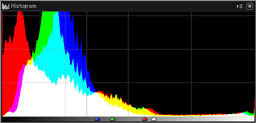 Histogram displays a brightness distribution on a picture.
Histogram displays a brightness distribution on a picture.
You can check which part of the picture has what level of brightness. The horizontal axis shows brightness (0-255), and the higher the value (right side), the greater the brightness.
The vertical axis shows the number of pixels that corresponds to relevant brightness level. R,G, and B are displayed in each color on a graph, and the place where these overlap it is displayed as an additive color mixture.
6.2.1. Display of Histogram
 Histogram displays a brightness distribution on a picture.
Histogram displays a brightness distribution on a picture.You can check which part of the picture has what level of brightness. The horizontal axis shows brightness (0-255), and the higher the value (right side), the greater the brightness.
The vertical axis shows the number of pixels that corresponds to relevant brightness level. R,G, and B are displayed in each color on a graph, and the place where these overlap it is displayed as an additive color mixture.
6.2.1. Display of Histogram
The arrow displayed on the gray scale at the bottom has the following meaning.
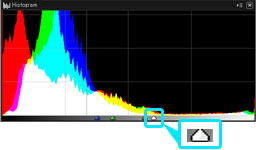
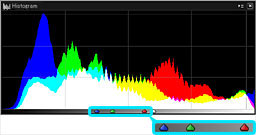
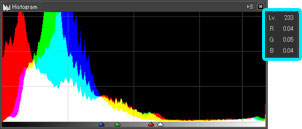 In addition, by clicking a graph, you can see each brightness statistic of the RGB.
In addition, by clicking a graph, you can see each brightness statistic of the RGB.
Lv is the value given to brightness (0 ~ 255) shown on the horizontal axis. "R," "G" and "B" are the statistcal values for RGB in percentage (%) units.
If the histogram of the image is evenly distributed for each RGB value (Lv value), the value for each statistical value 0 ~ 255 will be 1/256 = 0.39%.
For normal photographs, most of the area will be in the range of 0.00 ~ 2.00, but brightness distribution may be consolidated in a photograph whose subject is almost a single color, such as completely dark photographs and macro shots of flowers.

| (1) | Contrast center |
This indicates a contrast center of tone.

| (2) | RGB marker |
This displays RGB value at the point where the mouse cursor is on. The value corresponds to the brightness position on a graph.
It is very effective to check where a color of a point on a screen is distributed on a histogram.
It is very effective to check where a color of a point on a screen is distributed on a histogram.
 In addition, by clicking a graph, you can see each brightness statistic of the RGB.
In addition, by clicking a graph, you can see each brightness statistic of the RGB.Lv is the value given to brightness (0 ~ 255) shown on the horizontal axis. "R," "G" and "B" are the statistcal values for RGB in percentage (%) units.
If the histogram of the image is evenly distributed for each RGB value (Lv value), the value for each statistical value 0 ~ 255 will be 1/256 = 0.39%.
For normal photographs, most of the area will be in the range of 0.00 ~ 2.00, but brightness distribution may be consolidated in a photograph whose subject is almost a single color, such as completely dark photographs and macro shots of flowers.
6.3. Shortcut Keys and Function Keys
Shortcut keys and Function keys that you can use in SILKYPIX® Developer Studio 4.0 are shown below.
6.3.1. Operating Menu
| * | These are default settings, and you can customize the keys. Please refer to '9.4 Key Customization'. |
6.3.1. Operating Menu
6.3.1.1. File
6.3.1.2. Edit
6.3.1.3. Operation
6.3.1.4. Display
6.3.1.5. Parameter
| Open file | Ctrl + O |
| Open folder | Ctrl + F |
| Development | Ctrl + S |
| Ctrl + P |
| Undo | Ctrl + Z |
| Redo | Ctrl + Y |
| Select all scene | Ctrl + A |
| Copy development parameters | Ctrl + C |
| Paste development parameters | Ctrl + V |
| Initialize development parameters | Ctrl + X |
| Rotate CW (+90 degree) | Ctrl + R |
| Rotate CW (-90 degree) | Ctrl + E |
| Exposure bias tool | F2 |
| Gray balance tool | F3 |
| Skin development tool | F4 |
| Previous scene | F11 |
| Next scene | F12 |
| Switching display floating/control | F9 |
| Display grid | Ctrl + G |
| Histogram | Ctrl + H |
| Tone curve | Ctrl + M |
| Trimming setting | Ctrl + T |
| Copy development parameters | Ctrl + C |
| Paste development parameters | Ctrl + V |
| Initialize development parameters | Ctrl + X |
| Rotate CW (+90 degree) | Ctrl + R |
| Rotate CW (-90 degree) | Ctrl + E |
| Thumbnail Mode | Combination Mode | Preview Mode |
| Key | Operation | Single selection | Multiple selection | Single selection | Multiple selection | Single selection | Not for development |
| [F1] | Help | * | * | * | * | * | * |
| [F2] | Exposure bias tools | --- | --- | * | * | * | --- |
| [F3] | Gray balance tool | --- | --- | * | * | * | --- |
| [F4] | Skin development tool | --- | --- | * | * | * | --- |
| [F6] | Delete mark | * | * | * | * | * | * |
| [F7] | Copy/Move mark | * | * | * | * | * | * |
| [F8] | Reserve | * | * | * | * | * | --- |
| [F9] | Switching floating control display | * | * | * | * | * | * |
| [F11] | Previous scene | * | --- | * | --- | * | * |
| [F12] | Next scene | * | --- | * | --- | * | * |
| Ctrl+[A] | Select all scenes | * | * | * | * | --- | * |
| Ctrl+[C] | Copy development parameters | * | --- | * | --- | * | --- |
| Ctrl+[E] | Rotate CW (-90) | * | * | * | * | * | * |
| Ctrl+[F] | Open folder | * | * | * | * | * | * |
| Ctrl+[G] | Display grid | --- | --- | * | --- | * | * |
| Ctrl+[H] | Histogram | * | * | * | * | * | * |
| Ctrl+[M] | Tone curve | * | * | * | * | * | * |
| Ctrl+[O] | Open file | * | * | * | * | * | * |
| Ctrl+[P] | * | * | * | * | * | * | |
| Ctrl+[R] | Rotate CW (+90) | * | * | * | * | * | * |
| Ctrl+[S] | Development | * | --- | * | --- | * | --- |
| Ctrl+[T] | Trimming setting | * | --- | * | --- | * | --- |
| Ctrl+[V] | Paste development parameters | * | * | * | * | * | --- |
| Ctrl+[W] | Switch display mode | * | * | * | --- | * | * |
| Ctrl+[X] | Initialize development parameters | * | * | * | * | * | --- |
| Ctrl+[Y] | Redo | * | --- | * | --- | * | --- |
| Ctrl+[Z] | Undo | * | --- | * | --- | * | --- |
| Ctrl+[0] | Display magnification:Whole display | --- | --- | * | --- | * | * |
| Alt+Ctrl+[0] | Display magnification:100% | --- | --- | * | --- | * | * |
| Ctrl+[+] | Display magnification:Zoom in | --- | --- | * | --- | * | * |
| Ctrl+[-] | Display magnification:Zoom out | --- | --- | * | --- | * | * |
| Shift+[Up key] | Display magnification:Zoom in | --- | --- | * | --- | * | * |
| Shift+[Down key] | Display magnification:Zoom out | --- | --- | * | --- | * | * |
| Shift+[Right key] | Display magnification:100% | --- | --- | * | --- | * | * |
| Shift+[left key] | Display magnification:Whole display | --- | --- | * | --- | * | * |
| [PageUp] | ScrollUp | * | * | * | * | * | * |
| [PageDown] | ScrollDown | * | * | * | * | * | * |
| [Home] | Scroll to head | * | * | * | * | --- | * |
| [End] | Scroll to end | * | * | * | * | --- | * |
| * | This is the default setting. You can change to another key at "9.4. Key settings." |
6.4. How to Use Cloakroom
In the "Taste/parameter" sub-control, there are convenient ways to store and paste the development parameters.
6.4.1. Copy Development Parameter
6.4.1. Copy Development Parameter
A basic method of operation is described in "7.4 Initialize Development Parameter" and "7.5 Cloakroom of Development Parameter". This function is used to apply the development parameters, which are adjusted and set for one scene, to other scenes.
This is the same function as copying and pasting the development function parameters. This function can apply the development parameters to four scenes simultaneously.
6.4.2. Save Development Parameter Temporarily This is the same function as copying and pasting the development function parameters. This function can apply the development parameters to four scenes simultaneously.
The development parameters are determined after having finished adjustment. But it is sometimes necessary to temporarily record the development parameters on the way of adjustment.
Because if you have the temporary parameters, you can restart to adjust the parameters from the point where you lost the way, not from the beginning.
6.4.3. Compare Development Parameter Because if you have the temporary parameters, you can restart to adjust the parameters from the point where you lost the way, not from the beginning.
The [Temporary registration] can save not only the development parameters but also developed images, temporarily. When using this feature, you can compare two developed parameters.(*1)
The two parameters are temporarily registered And then you can compare the image switching the parameter.
We recommend you to use the this function in the Zoom tool mode. Then you can enlarge the portions of the whole image and compare them easily.
*1 When using this function, you need to set the "Maximize Cache" mode.
Please refer to '9.3.3.1 Enable Cache Preview' for the setting. Please understand that using this function will maximize usage of memory.
The two parameters are temporarily registered And then you can compare the image switching the parameter.
We recommend you to use the this function in the Zoom tool mode. Then you can enlarge the portions of the whole image and compare them easily.
*1 When using this function, you need to set the "Maximize Cache" mode.
Please refer to '9.3.3.1 Enable Cache Preview' for the setting. Please understand that using this function will maximize usage of memory.